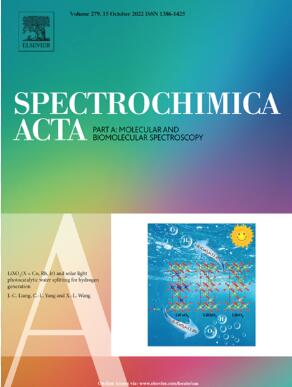右旋发酵白药健治疗肺部炎症的中红外光谱鉴定
IF 4.3
2区 化学
Q1 SPECTROSCOPY
Spectrochimica Acta Part A: Molecular and Biomolecular Spectroscopy
Pub Date : 2025-05-22
DOI:10.1016/j.saa.2025.126460
引用次数: 0
摘要
白药膏是一种由五倍子、茶叶和酒糟共同发酵而成的产品。白药健对肺部炎症有明显的治疗效果。在发酵过程中,白药煎中各成分含量不断变化,产生不同的抗炎作用。作为发酵药物,发酵时间对白药健的疗效和质量标准起着决定性的作用。因此,发酵时间的正确终点的确定是白药健发酵的首要质量标准。本研究采用中红外光谱(MIR)和高效液相色谱(HPLC)技术,结合白药煎的体外抗炎作用,确定了白药煎的最佳发酵时间。MIR谱图显示,发酵过程中单宁等有机化合物逐渐分解为没食子酸,在MIR的PCA评分图中可以明显区分不同发酵天数的白药健;HPLC分析结果显示,发酵过程中单宁和没食子酸衍生物被分解,没食子酸含量持续增加;细胞活性、NO、ROS、炎症因子及炎症因子mRNA表达水平均明确显示,随着发酵天数的增加,白药煎的抗炎作用显著增强,说明白药煎在治疗呼吸系统疾病方面具有良好的前景。同时,MIR光谱法可以简单、快速地鉴别正确发酵的白药健。本文章由计算机程序翻译,如有差异,请以英文原文为准。
Mid-infrared spectroscopic identification of the right-fermented Baiyaojian for pulmonary inflammation therapy
Baiyaojian is a product co-fermented from Chinese gallnut, tea leaves, and distillers’ grains. Baiyaojian shows a significant therapeutic effect in the treatment of pulmonary inflammation. In the process of fermentation, the content of components in Baiyaojian changes all the time, resulting in different anti-inflammatory effects. As a fermentation drug, the time of fermentation plays a decisive role in the efficacy and quality standards of Baiyaojian. Therefore, the determination of the right endpoint of the fermentation time is the primary quality standard for the fermentation of Baiyaojian. In this study, the best fermentation time of Baiyaojian was determined by mid-infrared (MIR) spectroscopy and high-performance liquid chromatography (HPLC), combined with the in vitro anti-inflammatory effect of Baiyaojian. MIR spectra showed that organic compounds such as tannins were gradually decomposed into gallic acid during fermentation, and Baiyaojian with different fermentation days could be clearly distinguished in the PCA score map of MIR; HPLC showed that tannins and gallic acid derivatives were decomposed during fermentation, and the content of gallic acid continued to increase; Cell activity, NO, ROS, inflammatory factors and mRNA expression levels of inflammatory factors clearly showed that with the increase of fermentation days, the anti-inflammatory effect of Baiyaojian was significantly improved, which means Baiyaojian has a good prospect in the treatment of respiratory diseases. Meanwhile, MIR spectroscopy can identify the right-fermented Baiyaojian simply and rapidly.
求助全文
通过发布文献求助,成功后即可免费获取论文全文。
去求助
来源期刊
CiteScore
8.40
自引率
11.40%
发文量
1364
审稿时长
40 days
期刊介绍:
Spectrochimica Acta, Part A: Molecular and Biomolecular Spectroscopy (SAA) is an interdisciplinary journal which spans from basic to applied aspects of optical spectroscopy in chemistry, medicine, biology, and materials science.
The journal publishes original scientific papers that feature high-quality spectroscopic data and analysis. From the broad range of optical spectroscopies, the emphasis is on electronic, vibrational or rotational spectra of molecules, rather than on spectroscopy based on magnetic moments.
Criteria for publication in SAA are novelty, uniqueness, and outstanding quality. Routine applications of spectroscopic techniques and computational methods are not appropriate.
Topics of particular interest of Spectrochimica Acta Part A include, but are not limited to:
Spectroscopy and dynamics of bioanalytical, biomedical, environmental, and atmospheric sciences,
Novel experimental techniques or instrumentation for molecular spectroscopy,
Novel theoretical and computational methods,
Novel applications in photochemistry and photobiology,
Novel interpretational approaches as well as advances in data analysis based on electronic or vibrational spectroscopy.

 求助内容:
求助内容: 应助结果提醒方式:
应助结果提醒方式:


